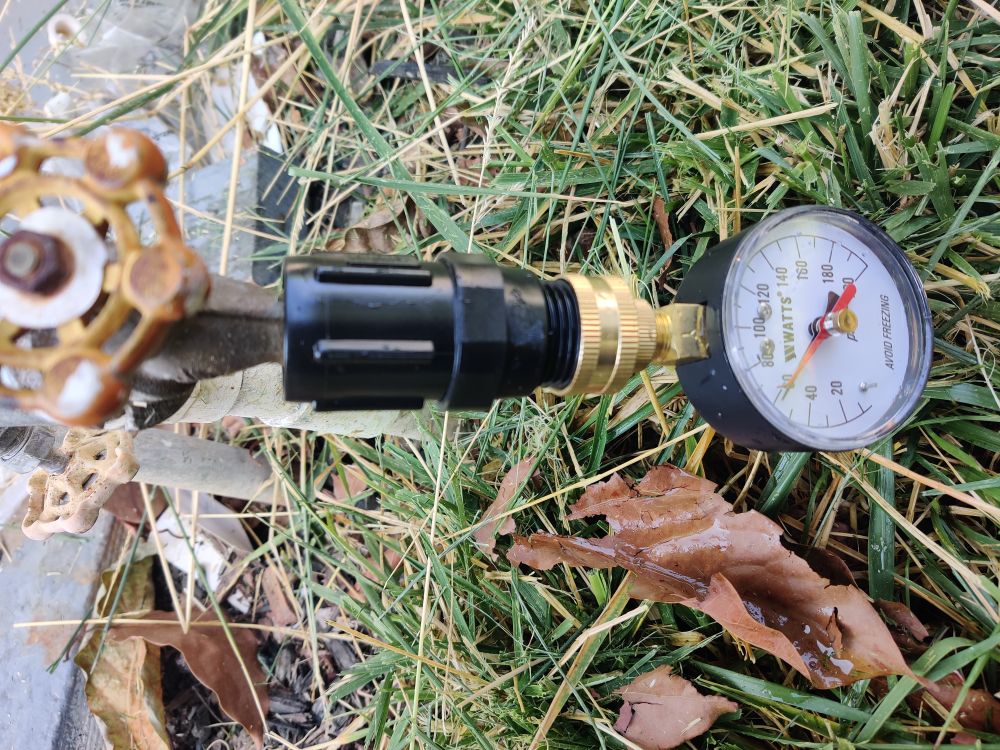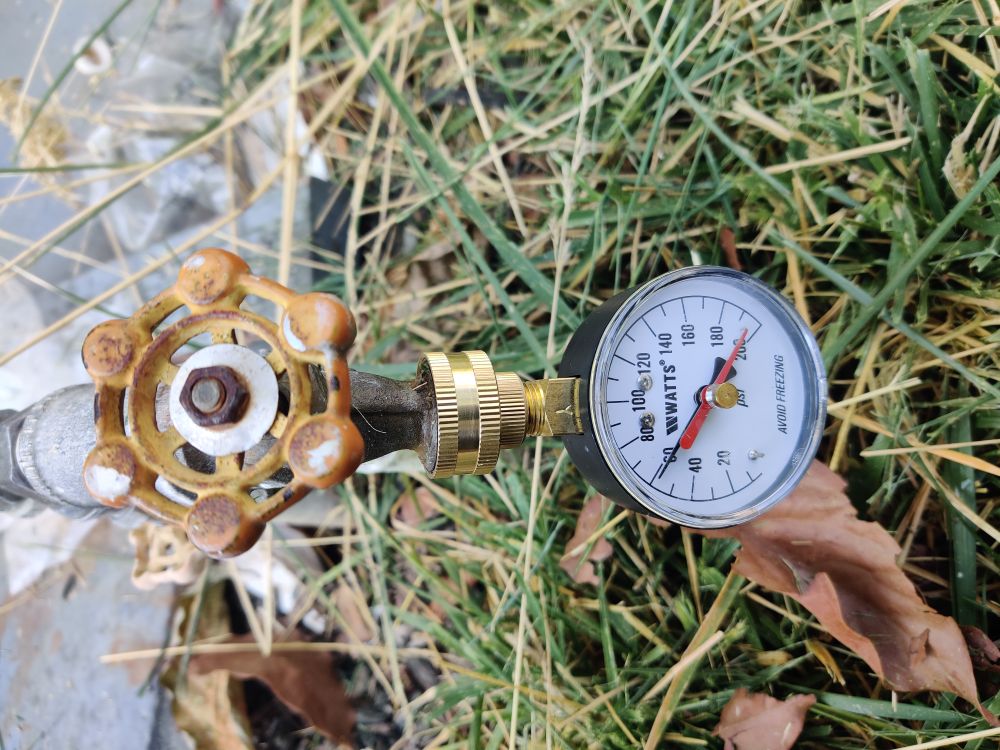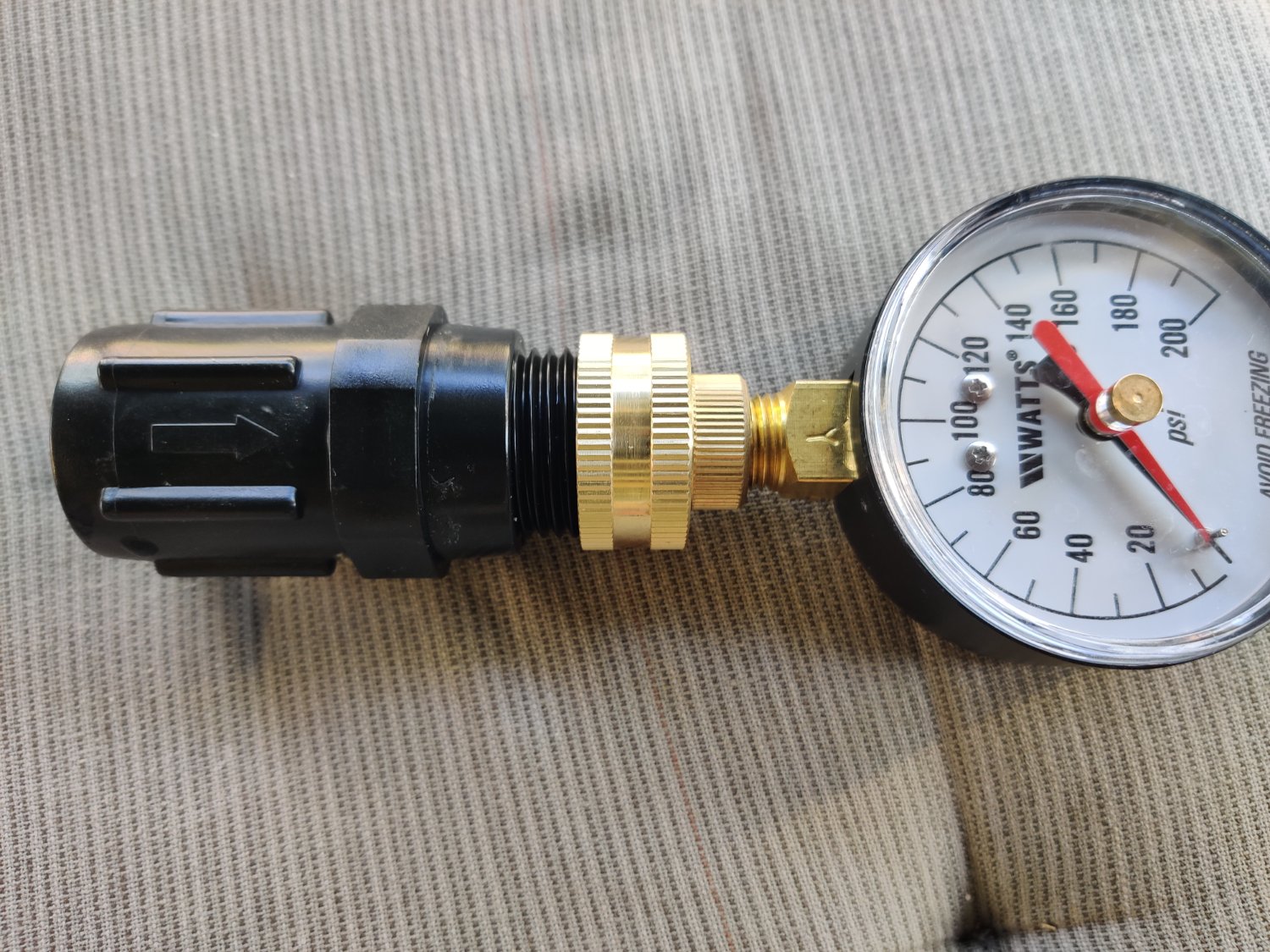[EDIT2] (at top to make sure visibility) All good, as explained in one of the posts. I shouldn’t expect pressure regulator to work directly at faucet. (Use tee or splitter) Here is video https://youtu.be/gp4aquT19LA
[Just started looking into drip irrigation] I’m using rainbird 25PSI pressure regulator along with pressure guage. (https://www.amazon.com/Rain-Bird-HT07525PSI-Irrigation-Regulator/dp/B0049C5FZA)
Pressure guage measures about 70PSI without regulator (directly at garden faucet), however this doesn’t really change even after using pressure regulator.
Am I misunderstanding pressure regulator? or is guauge/regulator broken?
[EDIT] Here is what I’m talking about (in both cases it reads about 60PSI):


Regulators are extremely simple devices, they’re insanely hard to actually screw up. Make sure you’re measuring at the output side.
There is only one way to connect pressure regulator though (hopefully I’m not attaching in reverse order)
Here’s a video detailing the order you should install your head assembly parts.
https://youtube.com/watch?v=r-mWxxqZpKM
I found this channel incredibly helpful in setting up my drip irrigation
this is the channel I watched (specifically this: https://www.youtube.com/watch?v=Z4zoMKT0La8)
I just want to echo what everyone else is saying (and I haven’t seen you confirm) that you’re putting your pressure gauge downstream from the pressure regulator of you’re trying to check the regulated pressure.
 There is arrow on regulator and pressure guage is downstream (arrow pointing towards it)
Also added 2 pics to original post.
There is arrow on regulator and pressure guage is downstream (arrow pointing towards it)
Also added 2 pics to original post.I think I connected it correctly but please let me know if I misunderstood it.
Hey there.
Pressure regulators typically only work when there is flow and also back pressure they can work against.
If you try and measure with the gauge like in the picture you will basically end up measuring input pressure as any tiny leakage of water through the regulator will have nowhere to go afterwards and pressure will build up.
If you want to test the regulator, you need to put it in a line with a few sprinkler heads on it so that there is both flow and back pressure and then put your gauge in a tee piece on that line so it can measure the pressure of the water flowing past.
Ah so I misunderstood how to use guage and in general how regulator works. Thanks for mentioning this. Would it work if I use splitter instead of tee ? (I’ve splitter readily available to test tomorrow)
Think of the pressure gauge like a valve, if the hose is running, turning it up and down increases/decreases the pressure drop across the valve, and by extension, the flow.
If you plug the end of the hose so nothing is flowing, turning up and down the valve does nothing to the pressure in the plugged line
There are more advanced pressure regulators that aren’t as dependent on flow, but this is not one of them.
Splitter is fine as long as there is somewhere for the water to go after it exits the regulator. You need that flow for it to work.
Just know that you also need a bit of back pressure so the regulator can actually reach the point of regulation, I mentioned sprinkler heads but this back pressure can be a hose with a nozzle, or just your thumb on the end even, as long as there is a bit of flow 😄
absolutely this, life is all good once I used splitter. I can see pressure guage reading 60-65PSI vs 20-25PSI. Thanks a lot for pointing this out
Looks correct in my amateur opinion. Appears not to be working. I checked the Amazon link you sent and seems like others are having the same problem with this model.
Going to try tee approach as mentioned in other post otherwise considering it defective.
Doesn’t one picture show 195 psi and the other 59? I think your gauge is out, tap pressure shouldn’t be almost 200 psi.
oh don’t worry about red needle (it’s some kind of inertia guage?), it’s pushed by black needle as soon as water starts and can be freely moved by dial on top
@SchmidtGenetics @rando my tap pressure had always been around 195. I now have 2 regulators inside house that I never needed before I got a new hot water heater. Incredible outside pressure, have to be careful with soaker in garden.
Pex is rated at 120 psi at hot water temperatures and only 160 psi at room temperature. So I seriously doubt that.
Rated pressure != burst pressure. I would expect a line rated at 160PSI line pressure to withstand at least 200PSI before bursting.
Water hammer can drastically increase line pressure; a line rated at 160PSI should be able to handle the transient pressure spikes that commonly occur in a 160PSI line.
Deliberately pushing 200PSI into a line rated for 160PSI is certainly not safe or acceptable, but I wouldn’t be surprised to see it hold, and I would be surprised to see it fail.
Looks like there’s some less than stellar reviews. It’s possible there’s a small action period of the valve leading to a pressurized pocket in the way you have the gage set up (that wouldn’t be there under normal flow operations). If you hook a hose up with and without the regulator, is there a difference in flow?
If you do see the expected difference in flow then you’ll just need to add a T for your indicator if you really want to keep an eye on pressure.
oh didn’t try it with hose, will test it (mostly tomorrow). I don’t really want permanent pressure guage, just making sure pressure is good before I install tubing.
Keep me posted! I’m very curious now. but yeah, without knowing anything about the internals, it’s possible the mechanisms needs some modicum of flow to regulate. If it’s a simple valve seat on a spring, I could see the downstream section reaching upstream pressure before spring drives it shut. The downstream assembly in this case is so small and totally sealed, so it wouldn’t take much for the air in it to be at supply pressure.
If that’s the case it’s nothing to worry about (probably). It’ll mean there’s a momentary spike to every time it’s opened, which could walk loose your barb fittings over time, but any flow distribution from the drip lines themselves will lessen that spike.
The hose test is the simplest “yup, there’s less flow and pressure” (if you wanted to be a real jackass about it you could make sure the hose is bent the same and at the same elevation in both cases, and track how far the arc travels). Another thing you could do is 1) open the upstream supply decently but not full blast (you want it open enough to ensure it’s not limiting flow it’s self but you won’t need the full flow it can provide) then 2) loosen the gauge to the point where it’s leaking decently.
You should a rapid but not instantaneous pressure drop to the 25psi of the regulator. Again it’s possible the mechanism requires flow, but in a perfect world you’d be able to tighten the gauge back up and then it would NOT rise back to supply pressure.
This all assumes it’s not simply malfunctional.
Yes it just needed guage in tee and regulator needs flow.
Awesome. Glad it worked out. Thanks for the followup!




